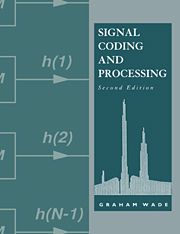Book contents
- Frontmatter
- Contents
- Preface
- Abbreviations
- 1 PCM signals and systems
- 2 Source coding
- 3 Channel coding
- 4 Digital filters
- 5 Discrete transforms
- Problems
- Appendix A Transposition of digital filters using signal flow graphs
- Appendix B Fixed-point arithmetic
- Appendix C C-routine for FIR filter design
- Appendix D C-routine for DIT in-place radix-2 FFT
- Appendix E C-routine for Meggitt decoder simulation
- References
- Index
1 - PCM signals and systems
Published online by Cambridge University Press: 05 June 2012
- Frontmatter
- Contents
- Preface
- Abbreviations
- 1 PCM signals and systems
- 2 Source coding
- 3 Channel coding
- 4 Digital filters
- 5 Discrete transforms
- Problems
- Appendix A Transposition of digital filters using signal flow graphs
- Appendix B Fixed-point arithmetic
- Appendix C C-routine for FIR filter design
- Appendix D C-routine for DIT in-place radix-2 FFT
- Appendix E C-routine for Meggitt decoder simulation
- References
- Index
Summary
This chapter examines theoretical and practical aspects of pulse code modulation (PCM) because of its direct relevance to the coding techniques presented in Chapters 2 and 3.
We start by comparing PCM with Shannon's ideal coding concept and by highlighting its noise immunity compared to uncoded systems. The chapter then examines the two fundamental aspects of PCM (sampling and quantizing) from theoretical and practical standpoints, and illustrates how sampling rates and quantizing noise can be ‘adjusted’ in order to convert efficiently analogue signals to PCM or vice-versa. Once in PCM form, a signal is usually processed by some source coding technique in order to satisfy a specific bit rate, and PCM network standards are outlined in Section 1.6.2. The chapter concludes by introducing the idea of channel coding, which is essentially a mechanism for matching the processed PCM signal to the transmission channel.
The ideal coding concept
Consider the receiver in Fig. 1.1 (essentially a demodulator or decoder) where Si and Ni are the average signal and noise powers for the input, So and No are the average signal and noise powers for the output, BT is the transmission bandwidth and Bm is the message bandwidth. In general (but not always) a practical receiver improves the signal-to-noise ratio (SNR) in exchange for signal bandwidth, so that by choosing a modulation or coding scheme such that BT ≫ Bm it should be possible for the receiver to deliver a high-quality signal despite a low Si/Ni ratio.
- Type
- Chapter
- Information
- Signal Coding and Processing , pp. 1 - 37Publisher: Cambridge University PressPrint publication year: 1994



